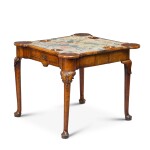
Property from an English Private Collection
A George I walnut 'concertina-action' card table, circa 1725
Lot Closed
May 17, 11:26 AM GMT
Estimate
10,000 - 15,000 GBP
Lot Details
Description
Property from an English Private Collection
A George I walnut 'concertina-action' card table, circa 1725
the quarter-veneered and feather-banded top opening to reveal a panel of contemporary needlework with four candlestands and counter wells, above a single feather-banded frieze drawer, the front legs headed with carved acanthus and bell-flower garlands, the rear legs headed with lappets, on pad feet
74cm. high, 89cm. wide, 44cm. deep (closed); 2ft. 5¼in., 2ft. 11in., 1ft. 5¼in.
sold Sotheby's London, 24 November 2004, lot 79 (£28,000 hammer) where acquired by the present owner.
RELATED LITERATURE
Adam Bowett, Early Georgian Furniture 1715-1740, Woodbridge, 2009, pp. 260-265.
This table is an extremely sophisticated example of its type and represents the apogee of card table design in the early Georgian era. From circa 1700 onwards, purpose-built card tables became increasingly common as the craze for games swept across Europe (A. Bowett, op. cit., pp. 260-265). Early examples were typically of demi-lune form and suited to the playing of the three-hand game Ombre. By 1720, the French four-hand game of Quadrille was de rigueur and perhaps coincided with the rise in popularity of four-sided square tables. The present table exudes quality, displaying carefully chosen book-matched walnut veneers to the hinged top which is supported by a ‘concertina’ action base. Retaining its original needlework, the acanthus motifs to each corner echo the carved details to the front legs while the serpentine frieze follows the outline of the top which is fitted with counter wells and candle dishes to the corners.
For related examples with needlework covered tops in walnut and mahogany, see those illustrated P. Macquoid and R. Edwards, (Rev. Ed. R. Edwards), The Dictionary of English Furniture, Vol. III, England, 1986, pp. 196-197, figs. 10, 14 & 16.
You May Also Like










